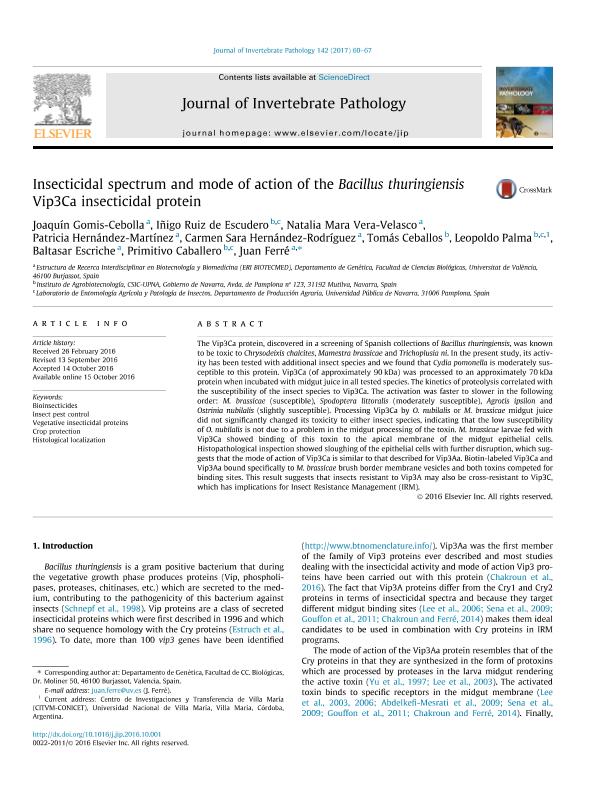Mostrar el registro sencillo del ítem
dc.contributor.author
Gomis-Cebolla, Joaquín
dc.contributor.author
Ruiz de Escudero, Iñigo
dc.contributor.author
Vera-Velasco, Natalia Mara
dc.contributor.author
Hernández-Martínez, Patricia
dc.contributor.author
Hernández-Rodríguez, Carmen Sara
dc.contributor.author
Ceballos, Tomás
dc.contributor.author
Palma, Leopoldo

dc.contributor.author
Escriche, Baltasar
dc.contributor.author
Caballero, Primitivo
dc.contributor.author
Ferré, Juan
dc.date.available
2020-02-13T17:42:38Z
dc.date.issued
2017-01
dc.identifier.citation
Gomis-Cebolla, Joaquín; Ruiz de Escudero, Iñigo; Vera-Velasco, Natalia Mara; Hernández-Martínez, Patricia; Hernández-Rodríguez, Carmen Sara; et al.; Insecticidal spectrum and mode of action of the Bacillus thuringiensis Vip3Ca insecticidal protein; Academic Press Inc Elsevier Science; Journal of Invertebrate Pathology; 142; 1-2017; 60-67
dc.identifier.issn
0022-2011
dc.identifier.uri
http://hdl.handle.net/11336/97419
dc.description.abstract
The Vip3Ca protein, discovered in a screening of Spanish collections of Bacillus thuringiensis, was known to be toxic to Chrysodeixis chalcites, Mamestra brassicae and Trichoplusia ni. In the present study, its activity has been tested with additional insect species and we found that Cydia pomonella is moderately susceptible to this protein. Vip3Ca (of approximately 90 kDa) was processed to an approximately 70 kDa protein when incubated with midgut juice in all tested species. The kinetics of proteolysis correlated with the susceptibility of the insect species to Vip3Ca. The activation was faster to slower in the following order: M. brassicae (susceptible), Spodoptera littoralis (moderately susceptible), Agrotis ipsilon and Ostrinia nubilalis (slightly susceptible). Processing Vip3Ca by O. nubilalis or M. brassicae midgut juice did not significantly changed its toxicity to either insect species, indicating that the low susceptibility of O. nubilalis is not due to a problem in the midgut processing of the toxin. M. brassicae larvae fed with Vip3Ca showed binding of this toxin to the apical membrane of the midgut epithelial cells. Histopathological inspection showed sloughing of the epithelial cells with further disruption, which suggests that the mode of action of Vip3Ca is similar to that described for Vip3Aa. Biotin-labeled Vip3Ca and Vip3Aa bound specifically to M. brassicae brush border membrane vesicles and both toxins competed for binding sites. This result suggests that insects resistant to Vip3A may also be cross-resistant to Vip3C, which has implications for Insect Resistance Management (IRM).
dc.format
application/pdf
dc.language.iso
eng
dc.publisher
Academic Press Inc Elsevier Science

dc.rights
info:eu-repo/semantics/openAccess
dc.rights.uri
https://creativecommons.org/licenses/by-nc-sa/2.5/ar/
dc.subject
BIOINSECTICIDES
dc.subject
CROP PROTECTION
dc.subject
HISTOLOGICAL LOCALIZATION
dc.subject
INSECT PEST CONTROL
dc.subject
VEGETATIVE INSECTICIDAL PROTEINS
dc.subject.classification
Biología Celular, Microbiología

dc.subject.classification
Ciencias Biológicas

dc.subject.classification
CIENCIAS NATURALES Y EXACTAS

dc.title
Insecticidal spectrum and mode of action of the Bacillus thuringiensis Vip3Ca insecticidal protein
dc.type
info:eu-repo/semantics/article
dc.type
info:ar-repo/semantics/artículo
dc.type
info:eu-repo/semantics/publishedVersion
dc.date.updated
2020-02-12T17:48:32Z
dc.journal.volume
142
dc.journal.pagination
60-67
dc.journal.pais
Estados Unidos

dc.description.fil
Fil: Gomis-Cebolla, Joaquín. Universidad de Valencia; España
dc.description.fil
Fil: Ruiz de Escudero, Iñigo. Universidad Publica de Navarra; España
dc.description.fil
Fil: Vera-Velasco, Natalia Mara. Universidad de Valencia; España
dc.description.fil
Fil: Hernández-Martínez, Patricia. Universidad de Valencia; España
dc.description.fil
Fil: Hernández-Rodríguez, Carmen Sara. Universidad de Valencia; España
dc.description.fil
Fil: Ceballos, Tomás. Universidad de Valencia; España
dc.description.fil
Fil: Palma, Leopoldo. Universidad Publica de Navarra; España. Consejo Nacional de Investigaciones Científicas y Técnicas. Centro Científico Tecnológico Conicet - Córdoba. Centro de Investigaciones y Transferencia de Villa María. Universidad Nacional de Villa María. Centro de Investigaciones y Transferencia de Villa María; Argentina
dc.description.fil
Fil: Escriche, Baltasar. Universidad de Valencia; España
dc.description.fil
Fil: Caballero, Primitivo. Universidad Publica de Navarra; España
dc.description.fil
Fil: Ferré, Juan. Universidad de Valencia; España
dc.journal.title
Journal of Invertebrate Pathology

dc.relation.alternativeid
info:eu-repo/semantics/altIdentifier/url/https://www.sciencedirect.com/science/article/pii/S0022201116301550
dc.relation.alternativeid
info:eu-repo/semantics/altIdentifier/doi/https://doi.org/10.1016/j.jip.2016.10.001
Archivos asociados
